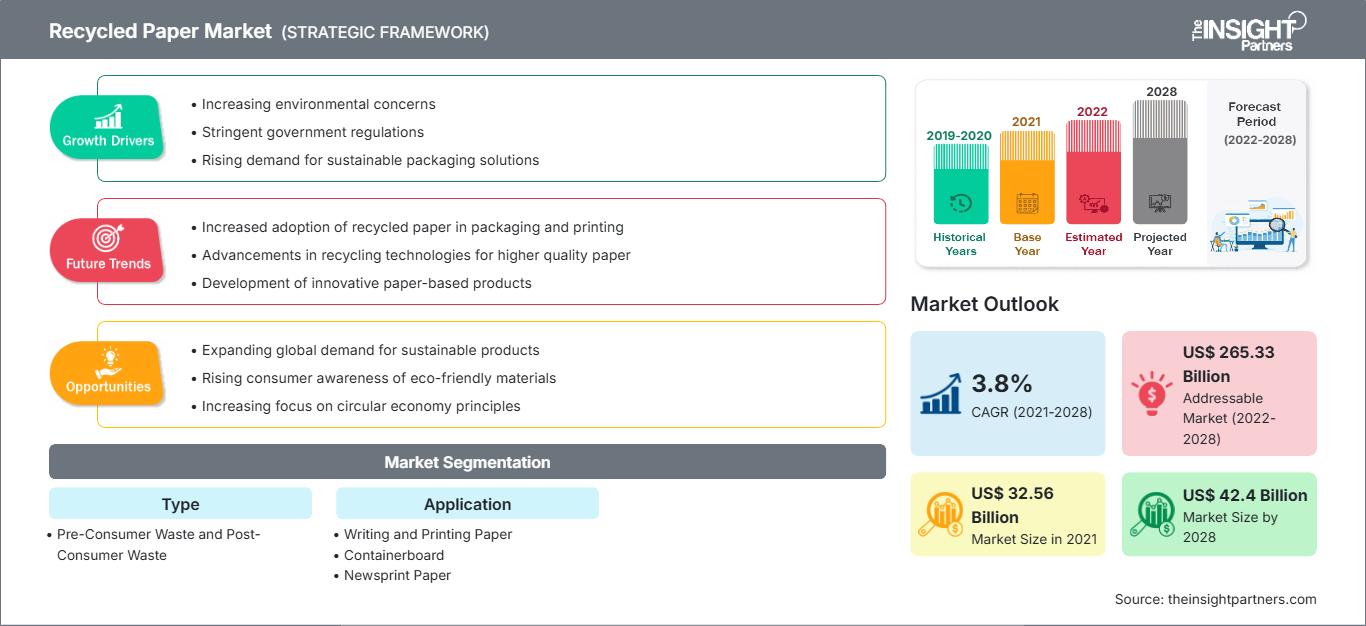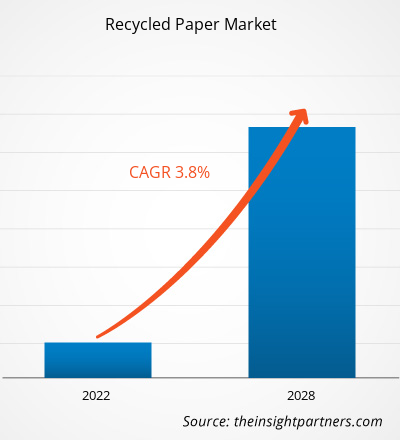Der Markt für Recyclingpapier soll von 32.558,44 Millionen US-Dollar im Jahr 2021 auf 42.395,79 Millionen US-Dollar im Jahr 2028 wachsen; die durchschnittliche jährliche Wachstumsrate (CAGR) liegt zwischen 2021 und 2028 bei 3,8 %.
Die Nachfrage nach Recyclingpapier steigt aufgrund zunehmender Initiativen von Regierungen verschiedener Länder zur Förderung des Altpapierrecyclings deutlich an. Recyclingpapier beschränkt sich auf Papier für industrielle Anwendungen, umfasst aber auch Haushaltsabfälle wie Zeitungen, Zeitschriften und Verpackungspapier. Das aus diesen Quellen stammende Abfallaufkommen ist sehr hoch und dieser Abfall muss recycelt werden, anstatt ihn zu deponieren oder zu verbrennen. Mit der Umsetzung staatlicher Vorschriften und der Gründung neuer Verbände im Bereich Recyclingpapier wird der Markt für Recyclingpapier in den kommenden Jahren voraussichtlich stark wachsen.
Der Markt für Recyclingpapier im asiatisch-pazifischen Raum soll im Prognosezeitraum die höchste CAGR erreichen. Viele Länder im Asien-Pazifik-Raum, darunter Australien, China, Indien und Japan, verfügen über zahlreiche Fertigungsindustrien, beispielsweise in den Bereichen Stahl, Bergbau und Metallurgie, Petrochemie, Öl und Gas, Nahrungsmittel und Getränke sowie Textil. Mit dem schnellen Wirtschaftswachstum und der Urbanisierung werden Abfallerzeugung und -management in Asien zu großen sozialen und ökologischen Problemen. Jedes Land in Asien verfügt über spezifische Maßnahmen zur Abfallbewirtschaftung und Materialkreislaufpolitik. Eine Deponie ist in vielen asiatischen Ländern die gängigste Entsorgungsoption, da sie kostengünstig ist. Viele Länder in dieser Region haben vor Kurzem Gesetze zu Siedlungsabfällen (MSW) erlassen. Laut der Weltbank produzieren die städtischen Gebiete in APAC täglich ca. 760.000 Tonnen MSW, und diese Zahl wird bis 2025 Schätzungen zufolge auf 1,8 Millionen Tonnen ansteigen. Die potenzielle Nachfrage nach Produkten wie weißem und farbigem Papier, Karton, Zeitungen, Zeitschriften und Broschüren, geschreddertem Papier sowie gedruckten Dokumenten aus verschiedenen Branchen im Asien-Pazifik-Raum steigt. Dadurch steigt der Bedarf an Recyclingpapier im asiatisch-pazifischen Raum und das Marktwachstum wird angekurbelt.
Passen Sie diesen Bericht Ihren Anforderungen an
Sie erhalten kostenlos Anpassungen an jedem Bericht, einschließlich Teilen dieses Berichts oder einer Analyse auf Länderebene, eines Excel-Datenpakets sowie tolle Angebote und Rabatte für Start-ups und Universitäten.
Markt für Recyclingpapier: Strategische Einblicke

-
Holen Sie sich die wichtigsten Markttrends aus diesem Bericht.Dieses KOSTENLOSE Beispiel umfasst Datenanalysen, die von Markttrends bis hin zu Schätzungen und Prognosen reichen.
Auswirkungen der COVID-19-Pandemie auf den Recyclingpapiermarkt
Die COVID-19-Pandemie hat den Status des Chemie- und Werkstoffsektors drastisch verändert und das Wachstum des Recyclingpapiermarktes negativ beeinflusst. Die Umsetzung von Maßnahmen zur Eindämmung der Virusausbreitung hat die Situation verschärft und das Wachstum mehrerer Industriezweige beeinträchtigt. Die plötzliche Verzerrung hat sich auf die Betriebseffizienz von Branchen wie der Automobil- und Verpackungsindustrie ausgewirkt und zu Störungen der Wertschöpfungsketten geführt, die auf die plötzliche Schließung nationaler und internationaler Grenzen zurückzuführen sind. Der deutliche Wachstumsrückgang mehrerer Industriezweige hat die Nachfrage nach Recyclingpapier auf dem Weltmarkt erheblich beeinträchtigt. Aufgrund der COVID-19-Pandemie hatte der Markt aufgrund von Fabrikschließungen auf der ganzen Welt negative Auswirkungen auf seine Produktion. Diese Pandemie wird den Prognosen zufolge den Markt für Recyclingpapier moderat beeinträchtigen; der Markt dürfte sich in den nächsten zwei bis drei Quartalen erholen.
Markteinblicke
Strenge staatliche Vorschriften für die Abfallwirtschaft
Das zunehmende Bewusstsein für die Umweltauswirkungen der Abfallansammlung und mangelnder Abfallbewirtschaftung ist einer der Hauptgründe dafür, dass verschiedene Regierungen weltweit Vorschriften für die Abfallwirtschaft erlassen haben. Die Papierrecyclingbranche expandiert in vielen Ländern wie den USA, Kanada, Indien, China, Japan und Deutschland. Die Regierungen verschiedener Nationen setzen Vorschriften um, um das Recycling von Altpapier zu fördern. Zahlreiche Verbände wie die American Forest & Paper Association (AF&PA), die Independent Waste Paper Processors Association (IWPPA), die Confederation of Paper Industries (CPI) und die European Recovered Paper Association (ERPA) unterstützen die Praxis des Papierrecyclings. Solche Verbände fördern das Wachstum des Recyclingpapiermarktes.
Typeneinblicke
Basierend auf dem Typ ist der Recyclingpapiermarkt in Pre-Consumer-Abfälle und Post-Consumer-Abfälle segmentiert. Das Segment Pre-Consumer-Abfälle hatte 2020 einen größeren Marktanteil und wird im Prognosezeitraum voraussichtlich schneller wachsen. Pre-Consumer-Recycling ist die Rückgewinnung von Abfallmaterialien, die bei der Herstellung oder dem Vertrieb von Produkten vor der Auslieferung an den Verbraucher entstehen. Pre-Consumer-Recyclingmaterialien können zerlegt und zu ähnlichen oder anderen Materialien wiederaufbereitet werden. Im Fall von Papier bezieht sich Pre-Consumer-Abfall auf die Abfälle und Verschnitte, die beim Schneideprozess abgeschnitten und entsorgt wurden. Daher wird erwartet, dass das Segment Pre-Consumer-Abfälle in den kommenden Jahren potenzielle Wachstumschancen bietet.
Anwendungseinblicke
Basierend auf der Anwendung ist der Recyclingpapiermarkt in Schreib- und Druckpapier, Wellpappe, Zeitungspapier, Tissue und andere segmentiert. Das Segment Containerpapier dürfte aufgrund der höchsten Produktion mit über 100 Millionen Tonnen jährlich wachsen. Das Wachstum des Druck- und Schreibpapiersegments ist auf die breite Anwendung in Büros, Haushalten, Schulen und Behörden zurückzuführen. Auch das Zeitungspapiersegment dürfte seinen Marktanteil aufgrund seiner Verwendung im Zeitungs- und anderen Druckverfahren ausbauen.
Zu den wichtigsten Akteuren auf dem Recyclingpapiermarkt gehören Cascades Recovery+; Global Waste Recyclers Ltd; Hanna Paper; Heinzel Holding GmbH; Republic Services, Inc.; International Paper; Perlen Papier; Sonoco Products Company; ST PAPER RESOURCES PTE LTD; und WASCO. Die wichtigsten Unternehmen verfolgen Strategien wie Fusionen und Übernahmen sowie Forschung und Entwicklung, um ihren Kundenstamm zu erweitern und signifikante Marktanteile auf dem Weltmarkt zu gewinnen, wodurch sie ihren Markennamen weltweit behaupten können.
Markt für Recyclingpapier
Die Analysten von The Insight Partners haben die regionalen Trends und Faktoren, die den Recyclingpapiermarkt im Prognosezeitraum beeinflussen, ausführlich erläutert. In diesem Abschnitt werden auch die Marktsegmente und die geografische Lage in Nordamerika, Europa, dem asiatisch-pazifischen Raum, dem Nahen Osten und Afrika sowie Süd- und Mittelamerika erörtert.Umfang des Marktberichts über Recyclingpapier
| Berichtsattribut | Einzelheiten |
|---|---|
| Marktgröße in 2021 | US$ 32.56 Billion |
| Marktgröße nach 2028 | US$ 42.4 Billion |
| Globale CAGR (2021 - 2028) | 3.8% |
| Historische Daten | 2019-2020 |
| Prognosezeitraum | 2022-2028 |
| Abgedeckte Segmente |
By Typ
|
| Abgedeckte Regionen und Länder |
Nordamerika
|
| Marktführer und wichtige Unternehmensprofile |
|
Dichte der Akteure auf dem Recyclingpapiermarkt: Verständnis ihrer Auswirkungen auf die Geschäftsdynamik
Der Markt für Recyclingpapier wächst rasant. Die steigende Nachfrage der Endverbraucher ist auf Faktoren wie veränderte Verbraucherpräferenzen, technologische Fortschritte und ein stärkeres Bewusstsein für die Produktvorteile zurückzuführen. Mit der steigenden Nachfrage erweitern Unternehmen ihr Angebot, entwickeln Innovationen, um den Bedürfnissen der Verbraucher gerecht zu werden, und nutzen neue Trends, was das Marktwachstum weiter ankurbelt.

- Holen Sie sich die Markt für Recyclingpapier Übersicht der wichtigsten Akteure
Berichts-Spotlights
- Fortschreitende Branchentrends im Recyclingpapiermarkt, um Akteuren bei der Entwicklung effektiver langfristiger Strategien zu helfen
- Geschäftswachstumsstrategien in entwickelten und sich entwickelnden Märkten
- Quantitative Analyse des Recyclingpapiermarktes von 2018 bis 2028
- Schätzung der weltweiten Nachfrage nach Recyclingpapier
- PEST-Analyse zur Veranschaulichung der Wirksamkeit von in der Branche tätigen Käufern und Lieferanten
- Jüngste Entwicklungen zum Verständnis des Wettbewerbsmarktszenarios
- Markttrends und -aussichten sowie Faktoren, die das Wachstum des Recyclingpapiermarktes vorantreiben und hemmen
- Unterstützung im Entscheidungsprozess durch Hervorhebung von Marktstrategien, die das kommerzielle Interesse untermauern und zum Marktwachstum führen
- Die Größe des Recyclingpapiermarktes an verschiedenen Knotenpunkten
- Detaillierte Übersicht und Segmentierung des Marktes sowie die Dynamik der Recyclingpapierbranche
- Größe des Recyclingpapiermarktes in verschiedenen Regionen mit vielversprechendem Wachstum Chancen
Markt für Recyclingpapier – nach Typ
- Abfall vor dem Verbrauch
- Abfall nach dem Verbrauch
Markt für Recyclingpapier – nach Anwendung
- Druckpapier
- Karton
- Zeitungspapier
- Tissue
- Sonstige
Firmenprofile
- Cascades Recovery+
- Global Waste Recyclers Ltd.
- Hanna Paper
- Heinzel Holding GmbH
- Republic Services, Inc.
- International Paper
- Perlen Papier
- Sonoco Products Company
- ST PAPER RESOURCES PTE LTD
- WASCO
- Historische Analyse (2 Jahre), Basisjahr, Prognose (7 Jahre) mit CAGR
- PEST- und SWOT-Analyse
- Marktgröße Wert/Volumen – Global, Regional, Land
- Branchen- und Wettbewerbslandschaft
- Excel-Datensatz
Aktuelle Berichte
Verwandte Berichte
Erfahrungsberichte
Grund zum Kauf
- Fundierte Entscheidungsfindung
- Marktdynamik verstehen
- Wettbewerbsanalyse
- Kundeneinblicke
- Marktprognosen
- Risikominimierung
- Strategische Planung
- Investitionsbegründung
- Identifizierung neuer Märkte
- Verbesserung von Marketingstrategien
- Steigerung der Betriebseffizienz
- Anpassung an regulatorische Trends






















 Kostenlose Probe anfordern für - Markt für Recyclingpapier
Kostenlose Probe anfordern für - Markt für Recyclingpapier